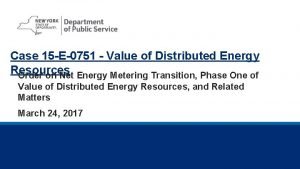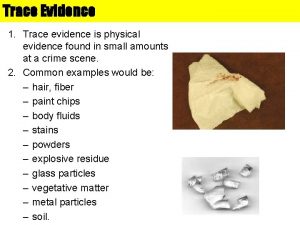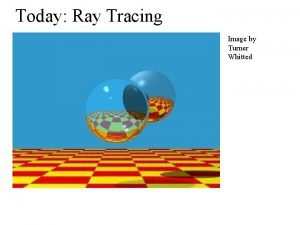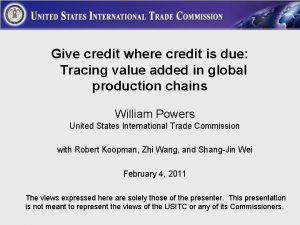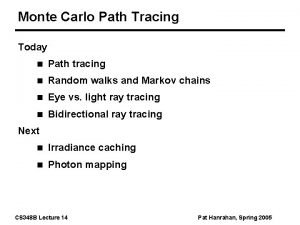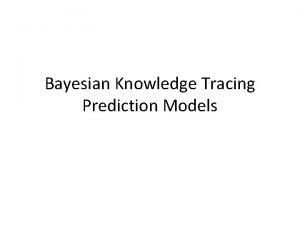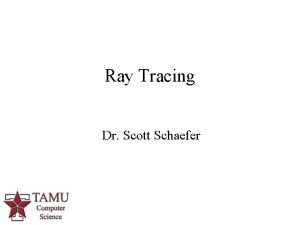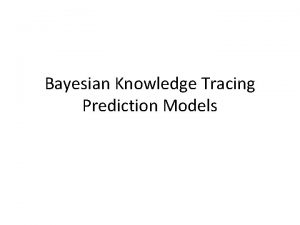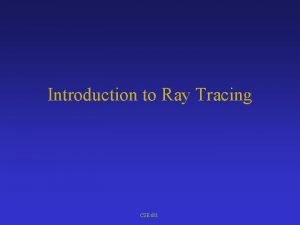Give credit where credit is due Tracing value


















- Slides: 18

Give credit where credit is due: Tracing value added in global production chains William Powers United States International Trade Commission with Robert Koopman, Zhi Wang, and Shang-Jin Wei February 4, 2011 The views expressed here are solely those of the presenter. This presentation is not meant to represent the views of the USITC or any of its Commissioners.

Presentation outline • Global value chain: nature and measures • Conceptual framework and its contribution – Three important matrices based on block-matrix formulation – Integration of other measures in the literature – Decomposition of gross exports completely into value-added components • Empirical results – Highlight regional differences in supply chain participation – Show differences in trade costs from multistage production • Database improvements and limitations – Extensions of the GTAP database – Connection to official statistics 1

Value chains, from a product view to a global view • What is a global value chain? – A system of value-added sources and destinations within a globally integrated production network • Literature – Single product: Dedrick, Kraemer, and Linden (2008) – Single country: Hummels, Ishii, Yi (2001), Koopman et al (2008) – Asian regional chains: Pula and Peltonen (2009); Wang, Powers, and Wei (2009) – Global snapshot: Daudin, Rifflart, and Schweisguth (2010); Johnson and Noguera (2010) – Global time series: Erumban et al. (2010); Wang et al. (2010) 2

Global value chains: Multiple measures • Hummels, Ishii, and Yi (2001) measures of vertical trade – VS: share of imported inputs in exports – VS 1: share of exports sent indirectly through third countries • Newer measures – VAX: domestic value-added in exports (Johnson and Noguera) – VS 1*: domestic value-added that returns home (Daudin et al. ) • aka “reflected” exports • Not previously unified in a fully specified framework – turn to this next 3

Value-added framework: Gross output in a two-country world • All output is used as an intermediate or final good at home or abroad with N goods, Xr: (N× 1) Gross output of country r Ars: (N×N) IO Coefficient matrix giving use in country s of intermediates from r Yrs: (N× 1) Final demand: Country s’s use of final goods from country r 4

Production system in a two-country world • In block matrix notation • Rearranging, where Bsr: (N×N) block Leontief inverse matrix, denoting the amount of total output in s required for a one-unit increase in final demand in country r Yr: (N× 1) vector of global use of r’s final goods 5

Value added in production • Direct domestic value added in production: and where Vr: (1×N) domestic value-added coefficient vector; element vri = 1 – intermediate input share from all countries u: (1×N) vector of ones • Value-added shares matrix (2× 2 N) decomposes value added in production of each sector in all countries 6

Value-added exports • Exports (2 N× 2) include both intermediate and final goods (See paper for value-added exports at the product level) • Value-added exports matrix (2× 2) • Fully generalizable to a many-country world 7

Incorporates all value-added measures • Vertical specialization: both direct (VS) and indirect (VS 1) • Domestic value added in exports (VAX) • Domestic value added that returns home (VS 1*) Domestic value added in exports (VAX ratio)— includes VS 1* Direct (VS): Foreign value added from 2 and 3 embodied in country 1’s exports Indirect (VS 1): Country 1’s value added embodied in 2’s and 3’s exports 8

Completely decomposes gross exports Gross exports Domestic value added in exports (VAX) Exports consumed by direct importer Final goods Further downstream Intermediate inputs Domestic value added that returns from abroad (VS 1*) Indirect exports sent to third countries Final goods Intermediate inputs Foreign value added in exports (VS) Final goods Intermediate inputs Indirect valueadded exports (VS 1) Further upstream in GVCs 9

Decomposition of gross exports Australia, New Zealand Japan EU 15 United States EFTA Canada Advanced economies India South Asia Rest of East Asia Indonesia China Vietnam Thailand Malaysia Philippines Emerging Asia Hong Korea Taiwan Asia NICs Russian Federation Brazil Rest Latin America Rest of the world South Africa EU accession countries Mexico Other emerging World average 0 20 40 60 Share of Gross Exports Domestic VA Foreign VA 80 100 Domestic VA returned 10

Supply chain participation: Key differences by region Australia, New Zealand Japan EU 15 United States EFTA Canada India South Asia Rest of East Asia Indonesia China Vietnam Thailand Malaysia Philippines Hong Korea Taiwan Russian Federation Brazil Rest of Americas Rest of the world South Africa EU accession countries Mexico Japan sends much of its domestic value to final suppliers indirectly through third countries (see table 3) US uses lots of imported inputs in its exports; imported value supplied by Canada, Mexico, and US itself Advanced economies Emerging Asia E. Asia has the longest chains–little of its exported value is absorbed by direct importer (see table 3) Asia NICs East Asia has the most foreign content in its own exports Other emerging Integration in NAFTA makes Mexico an outlier among non-Asian economies World average 0 20 40 60 80 Share of Gross Exports Domestic VA Foreign VA Domestic VA returned 100 11

Trade costs of multistage production Trade costs (tariff + transport), as a share of export value Trade costs on exports Trade costs on imported inputs • East Asia pays a price for its long chains and relatively high tariffs • Advanced economies have low foreign content and, hence, low costs 12

Database development: Estimating a global Inter-Region IO table • Start with 2004 GTAP global trade and prod’n database • Add additional detail on source and use of intermediate inputs and final goods (elements of Ars) • Use end-use categories of detailed trade data (HS 6) to improve imported intermediate use coefficients – UN Broad Economic Classification (BEC) distinguishes intermediate inputs from final goods in imports from each source in each sector – BEC is better than the alternative: Proportional method assumes the intermediate share in imports from each source is the same as in the home country’s domestic supply 13

BEC shows substantial export heterogeneity Intermediate share of U. S. electronic machinery imports, by source Share from US import use table (54. 2%) 14

Benefits and limitations of end-use classifications • End-use classifications improve estimates of intermediate inputs entering the importing country • Still have to assume proportionality to allocate intermediate inputs to each industry within the importing country – Required data not reported by most national statistical agencies – Problem noted by Committee on Economic Statistics of the American Economic Association (Feenstra et al. , 2010) • Industry-level estimates of value-added trade may be unreliable with unknown biases, despite their theoretical tractability 15

Conclusions • New value-added framework – Generalizes and harmonizes all measures in the literature – Accounts for the entirety of gross trade – Provides new detail on regional differences in supply chain activity and costs • It is now possible to measure trade in valueadded terms consistent with official statistics – Ideal database would be consistent with both official trade statistics and national income accounts 16

Questions/Comments? • Contact information – – – Bill Powers Research Division, Office of Economics U. S. International Trade Commission william. powers@usitc. gov (202) 708 -5405 17
 This can be avoided by giving credit where credit is due.
This can be avoided by giving credit where credit is due. Value creation value delivery value capture
Value creation value delivery value capture What is the main idea of give me liberty or give me death
What is the main idea of give me liberty or give me death Le diagonali del parallelogramma sono perpendicolari
Le diagonali del parallelogramma sono perpendicolari Procedural vs substantive due process
Procedural vs substantive due process Slidetodoc
Slidetodoc Due piccole sfere identiche sono sospese
Due piccole sfere identiche sono sospese Fv of ordinary annuity table
Fv of ordinary annuity table Future value formula annuity
Future value formula annuity Tabel nilai waktu uang
Tabel nilai waktu uang Credit value adjustment formula
Credit value adjustment formula Cdg value stack credit
Cdg value stack credit Wavefront
Wavefront Hull number example
Hull number example Thank you page
Thank you page Steam tracing
Steam tracing What is trace evidence examples
What is trace evidence examples Turner whitted
Turner whitted Lens ray tracing
Lens ray tracing











